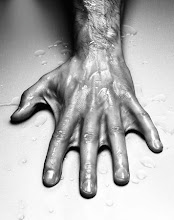Since I have little better to write about tonight, here is a continuation of the series on chocolate (Part 1, Part 2).
I am going to mention another method of tempering which begins with molten chocolate. Nearly all uses of chocolate begin with molten chocolate whether it's going to be tempered or not. For this reason we permanently keep enormous bowls of molten dark, milk and white chocolate in an étuve (heated cabinet). This way you can gain a lot of time when a recipe/decor calls for chocolate. Hence the practicality of tempering methods which start with molten chocolate.
An interesting by-thought is on the composition of the three chocolates:
| Dark | Milk | White | |
| Cocoa Solids | X | X | |
| Cocoa Butter | X | X | X |
| Sugar | X | X | X |
| Milk | X | X |
By looking at the ingredients like this it's easy to see that milk chocolate contains the essential elements of both milk and dark chocolate. For this reason, if you've been working with white chocolate but it's got contaminated with milk or dark chocolate (e.g. making the decor for the Pavé Royal) you can put any leftovers/cock ups straight back into the milk chocolate bowl in the étuve. And any dark chocolate which may have got a hint of milk or white chocolate can similarly be absorbed back into the milk chocolate mass. Neat-o.
TEMPERING METHOD III
'Tmust be said straight off that this is not a method I have road-tested; but the theory is sound and I've seen it recommended by a Meilleur Ouvrier de France chocolatier, so I think it's probably worth including to make the collection complete (although, NB, there are still more to come). This way of tempering risks taking a long time.
What one does
Put molten chocolate in bowl. Stir it.
How it works (assuming the basic theory here is clear)
As the chocolate slowly cools, assorted crystals will form at the edge (where coolest - think soup). Stirring helps speed up the cooling process. It also redistributes the assorted crystals back into the hotter part of the chocolate where they melt. There will come a time, though, when the mass of chocolate has sufficiently cooled that the beta crystals won't melt while the others will. These will be the seed crystals for the cooling chocolate and once there is a sufficient number, the chocolate is tempered. In a way, it is like the seeding method but instead of adding solid chocolate from without, you're letting it form from within the mass on the sides of the recipient.
If feeling bold, you can leave the chocolate some time without stirring it, until a good crystally crust forms round the edges. You just have to make sure the average temperature of the mass does not fall too far or you risk leaving unwanted crystals in the mix.
The problem with this method is that it's hard to know how you're progressing. There are no obvious indicators like there are with the seeding and tabling methods of how the crystallization is going. So although the method is very simple, it takes a good deal of experience to be able to judge when the chocolate is à point. For this reason, it is probably best to use a thermometer to guide you down to the 32°C you need (making sure you never get as low as 30°C). But, as mentioned before, temperature is only an approximate guide to crystallization...
Also, since chocolate is an excellent retainer of heat, this method could take a boringly long time.
Zzzzzz.


No comments:
Post a Comment